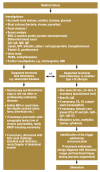The differential diagnosis of food intolerance
- PMID: 19547751
- PMCID: PMC2695393
- DOI: 10.3238/arztebl.2009.0359
The differential diagnosis of food intolerance
Abstract
Introduction: More than 20% of the population in industrialized countries suffer from food intolerance or food allergy.
Methods: Selective literature search for relevant publications in PubMed and the Cochrane Library combined with further data from the interdisciplinary database on chronic inflammatory and allergic diseases of the Erlangen University Hospital.
Results: The majority of cases of food intolerance (15% to 20%) are due to non-immunological causes. These causes range from pseudoallergic reactions to enzymopathies, chronic infections, and psychosomatic reactions that are associated with food intolerance. The prevalence of true food allergy, i.e., immunologically mediated intolerance reactions, is only 2% to 5%.
Conclusions: The differential diagnosis of food intolerance is broad. Therefore, a structured diagnostic algorithm with input from multiple clinical disciplines should be applied. The treatment consists of eliminating the offending substance from the diet as well as medications and psychosomatic support, when indicated.
Keywords: Food intolerance; critical appraisal; decision making; diagnosis; food allergy; histamine intolerance; provocative testing; quality assurance; study.
Figures




Comment in
-
Correction required.Dtsch Arztebl Int. 2010 Jan;107(3):39; author reply 40-1. doi: 10.3238/arztebl.2010.0039a. Epub 2010 Jan 15. Dtsch Arztebl Int. 2010. PMID: 20140176 Free PMC article. No abstract available.
-
Clinical relevance.Dtsch Arztebl Int. 2010 Jan;107(3):39; author reply 40-1. doi: 10.3238/arztebl.2010.0039b. Epub 2010 Jan 15. Dtsch Arztebl Int. 2010. PMID: 20140177 Free PMC article. No abstract available.
-
Bacteriological stool examinations.Dtsch Arztebl Int. 2010 Jan;107(3):40; author reply 40-1. doi: 10.3238/arztebl.2010.0040a. Epub 2010 Jan 15. Dtsch Arztebl Int. 2010. PMID: 20140178 Free PMC article. No abstract available.
References
-
- Crowe SE, Perdue MH. Gastrointestinal food hypersensitivity: basic mechanisms of pathophysiology. Gastroenterology. 1992;103:1075–1095. - PubMed
-
- Raithel M HE, Baenkler HW. Klinik und Diagnostik von Nahrungsmittelallergien (Gastrointestinal vermittelte Allergien Grad I-IV) Dtsch Arztebl. 2002;99(103):717–728.
-
- Teitelbaum JE FG. Immune mechanisms of food allergy. Curr Opin Gastroenterol. 1998;14:498–503.
-
- Aiuti F, Paganelli R. Food allergy and gastrointestinal diseases. Ann Allergy. 1983;51(2 Pt 2):275–280. - PubMed
-
- Baenkler H. Salicylatintoleranz: Pathophysiologie, klinisches Spektrum, Diagnostik und Therapie. Dtsch Arztebl. 2008;105(8):137–142. - PubMed
Publication types
MeSH terms
LinkOut - more resources
Full Text Sources
Medical
